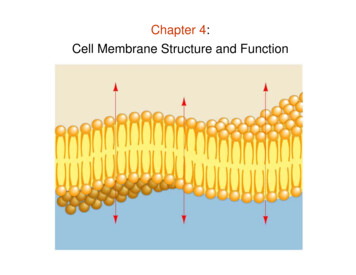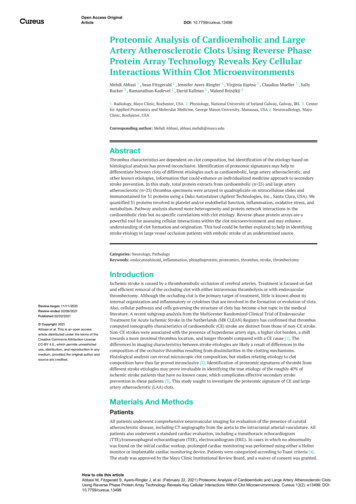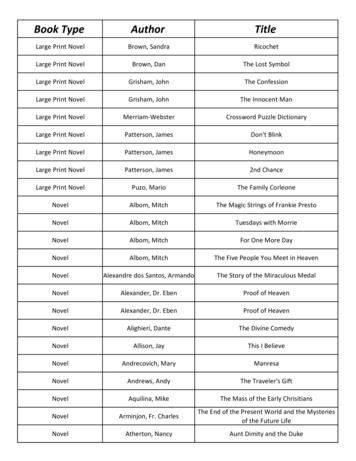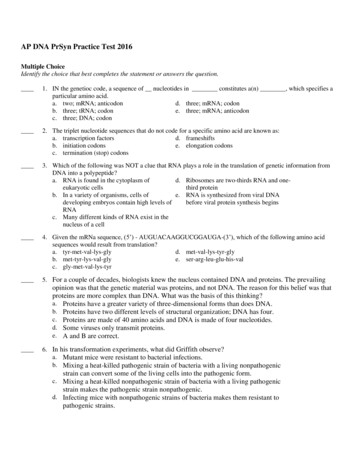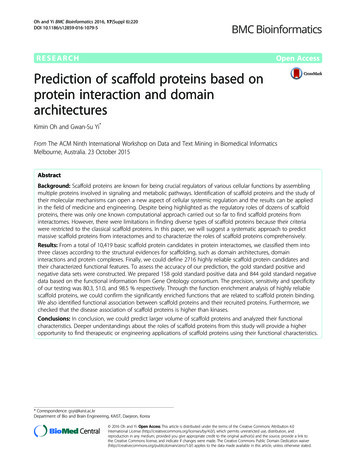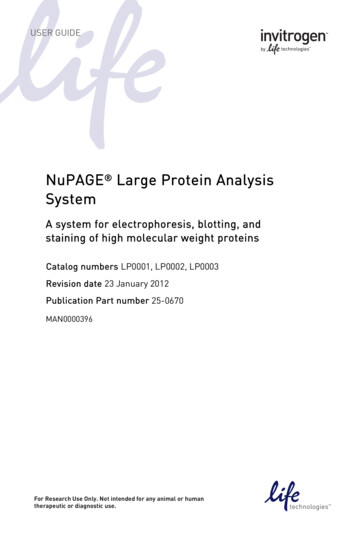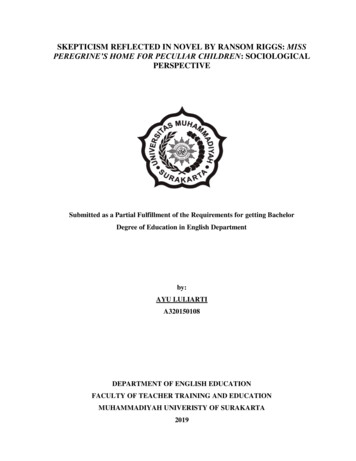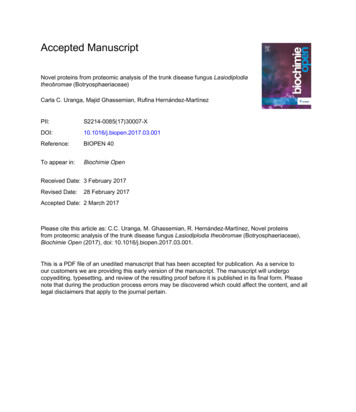
Transcription
Accepted ManuscriptNovel proteins from proteomic analysis of the trunk disease fungus Lasiodiplodiatheobromae (Botryosphaeriaceae)Carla C. Uranga, Majid Ghassemian, Rufina 0.1016/j.biopen.2017.03.001Reference:BIOPEN 40To appear in:Biochimie OpenReceived Date: 3 February 2017Revised Date:28 February 2017Accepted Date: 2 March 2017Please cite this article as: C.C. Uranga, M. Ghassemian, R. Hernández-Martínez, Novel proteinsfrom proteomic analysis of the trunk disease fungus Lasiodiplodia theobromae (Botryosphaeriaceae),Biochimie Open (2017), doi: 10.1016/j.biopen.2017.03.001.This is a PDF file of an unedited manuscript that has been accepted for publication. As a service toour customers we are providing this early version of the manuscript. The manuscript will undergocopyediting, typesetting, and review of the resulting proof before it is published in its final form. Pleasenote that during the production process errors may be discovered which could affect the content, and alllegal disclaimers that apply to the journal pertain.
ACCEPTED MANUSCRIPTRIPTCarla C. Urangaa, Majid Ghassemianb, Rufina Hernández-MartínezaaCentro de Investigación Científica y de Educación Superior de Ensenada (CICESE), CarreteraEnsenada-Tijuana 3918, Zona Playitas, 22860 Ensenada, B.C., E-mail:curanga@cicese.edu.mx, ruhernan@cicese.mxbUniversity of California, San Diego, Department of Chemistry and Biochemistry, 9500 GilmanDrive, La Jolla, CA 92093-0378, E-mail: mghassemian@ucsd.edu, Telephone: 534-822-0032.TEDMANUSCAbstractMany basic science questions remain regarding protein functions in the pathogen: hostinteraction, especially in the trunk disease fungi family, the Botryosphaeriaceae, which are aglobal problem for economically important plants, especially fruiting trees. Proteomics is ahighly useful technology for studying protein expression and for discovering novel proteins inunsequenced and poorly annotated organisms. Current fungal proteomics approaches involve 2DSDS-PAGE and extensive, complex, protein extraction methodologies. In this work, a modifiedFolch extraction was applied to protein extraction to perform both de novo peptide sequencingand peptide fragmentation analysis/protein identification of the plant and human fungal pathogenLasiodiplodia theobromae. Both bioinformatics approaches yielded novel peptide sequencesfrom proteins produced by L. theobromae in the presence of exogenous triglycerides andglucose. These proteins and the functions they may possess could be targeted for furtherfunctional characterization and validation efforts, due to their potential uses in biotechnology andas new paradigms for understanding fungal biochemistry, such as the finding of allergenicenolases, as well as various novel proteases, including zinc metalloproteinases homologous tothose found in snake venom. This work contributes to genomic annotation efforts, which, hand inhand with genomic sequencing, will help improve fungal bioinformatics databases for futurestudies of Botryosphaeriaceae. All data, including raw data, are available via theProteomeXchange data repository with identifier PXD005283. This is the first study of its kindin 2122232425262728293031323334Novel proteins from proteomic analysis of the trunk disease fungus Lasiodiplodiatheobromae (Botryosphaeriaceae)Keywords: Trunk-disease fungi, peptide fragmentation analysis, de novo peptide sequencing,bioinformatics, gene ontologyACC12351. Introduction36Current work in fungal proteomics and bioinformatics of phytopathogenic filamentous fungi is in37a very early stage. There are an estimated 1.5-5 million species of fungi thought to exist on earth38(1), and most of them remain unsequenced and uncharacterized. Apart from the importance of39efforts to understand fungal pathogenicity and pathogen: host-specific interactions, fungi are1
ACCEPTED MANUSCRIPTexcellent model organisms for gaining insight into the evolution of biochemical routes and their41conservation across kingdoms and taxa (2). Proteome analysis is a valuable technique for42studying protein expression of organisms in different biological and experimental contexts (3), as43well as for finding and annotating novel or unknown genome sequences (4). Proteins are the final44product of gene expression, and essentially the catalytic and metabolic force of an organism.45Because of the many possible post-translational modifications of proteins (5,6), proteomics is an46essential aspect of systematic gene expression studies for novel gene discovery.SCRIPT4047Peptide sequencing and protein identification allows for the identification of biomarkers in49pathological processes that may serve as indicators for disease and as targets for new treatments50(7). In the absence of genomic sequences for the organism of interest, proteomics analyses are51useful for designing biochemical characterization experiments via protein homology searches,52which provide clues to enzymatic processes in uncharacterized proteins that may then be verified53experimentally (3). Protein characterization efforts are critical for improving bioinformatics54databases available to the scientific community. Many programs exist to analyze peptides from a55sample (8) as well as for reverse-translating protein identifications to then search genome56sequences for homology, a valid approach for gene annotation and biochemical characterization57efforts (9).TEDEPACC58MANU4859One example of an important family of mostly unsequenced fungi is the Botryosphaeriaceae.60These are fungi that have been found to affect economically important woody plants around the61world (10). Several members if this family belong to “trunk disease fungi”, because they are able62to invade and kill fruiting trees (11,12). Emblematic symptoms from Botryosphaeriaceae consist2
ACCEPTED MANUSCRIPTof necrotic cankers in the trunks of the infected trees, reduced stature, and fruit rot (13). A64member of this family, Lasiodiplodia theobromae (teleomorph Botryosphaeria rhodina) has65been found to be the most virulent species among those reported in grapevine (14). L.66theobromae is able to colonize a broad range of plant species, including important plants such as67the rubber tree, (Hevea brasiliensis) (15), and the biofuel-producing plant Jatropha curcas (16).68Intriguingly, L. theobromae is also able to invade and colonize humans, and has been reported to69cause corneal ulcers, keratitis, onycomycosis, pneumonia in a transplant patient (17), and skin70lesions (18). Only partial sequences are available in the NCBI database, mostly consisting of ITS71regions used for species identification purposes.MANUSCRIPT6372Proteome studies from Botryosphaeriaceae (the proteome from Diplodia seriata is the only74Botryosphaeriaceae studied to date reported in the literature) have involved the use of 1D and 2D75SDS-PAGE (19) followed by mass spectrometry; laborious and technically difficult techniques76that yield limited protein identification data (20). Additionally, fungal proteins are notoriously77difficult to extract, because fungal cell walls contain chitin, and, in the case of L. theobromae,78extensive pigmentation (melanin) that interferes with the protein extraction (21). Currently,79protein extraction methods in fungi involve the use of painstaking, multi-step protein80precipitation protocols requiring controlled precipitating reagents like trichloroacetic acid (TCA)81or detergent extractions to prepcipitate proteins from aqueous suspensions, that result in protein82and information loss (22). In this work, lyophilized material was extracted directly using a83modified Folch extraction, conventionally used to extract lipids from biological material (23).84Previous metabolomic studies of this fungus showed that when cultivated in exogenous85triglycerides, a variety of fatty acid esters were produced (24), however, little is known about theACCEPTED733
ACCEPTED MANUSCRIPTproteins expressed by this fungus in this context. L. theobromae is a wound pathogen and is a87problem in many vineyards especially because of grafting practices (25–27). Lipids being one of88the exposed substrates, the objective of this work was to evaluate the proteome of L. theobromae89in the presence of exogenous triglycerides employing a multi-algorithm approach using90database-dependent fragmentation analysis in which a variety of databases were used. A de novo91peptide sequencing was also applied for comparison and for potential novel protein discovery.92SCRIPT862. Materials and Methods942.1 Fungal strains and incubation conditions95L. theobromae UCD256Ma (isolated in Madera County, California, USA) was provided by Dr.96Douglas Gubler from the University of California at Davis (13). The fungus isolate was97incubated in triplicate in 50 mL Vogel’s salts supplemented with 5% glucose and 5% grape seed98oil. All biological replicates were incubated for 20 days at 25 C in the dark and then lyophilized.99A modified Folch extraction consisted in the addition of 75 mL dichloromethane (DCM), 75 mL100methanol and 0.01% of the antioxidant butylated hydroxytoluene (BHT) to the lyophilized101material in each replicate and allowed to extract overnight at 4 C. The solvents were removed102from the solid material. For mass spectrometry-based peptide fragmentation analysis, a 0.5 g103portion of the solid material from each replicate was used to create a pool.TEDEPACC104MANU931052.2 Mass spectrometry methodology106The pooled samples were submitted to the University of California, San Diego proteomics mass107spectrometry department to be processed according to standard procedure. Briefly, 0.5 g of the108solids from the 50 mL fungal incubations (L. theobromae incubated in 5% glucose and 5%4
ACCEPTED MANUSCRIPTgrapeseed oil and Vogel’s salts for 20 days) remaining from the Folch extraction were dried110under a stream of nitrogen and re-suspended in 50 mM Tris buffer, pH 8.00. Acetonitrile was111added to the sample to a final concentration of 10%. The samples were then boiled for 5 min and112cooled to room temperature. TCEP (Tris (2-carboxyethyl) phosphine) was added to 1 mM (final113concentration) and the samples were incubated at 37 C for 30 min. Subsequently, the samples114were carboxymethylated with 0.5 mg/ml of iodoacetamide for 30 min at 37 C in dark followed115by neutralization with 2 mM TCEP (final concentration). Samples were boiled for 10 minutes116followed by protease digestion with a 1:100 ratio of trypsin: protein (Pierce Trypsin Protease,117MS Grade Catalog number: 90057 with K, R specificity). After an overnight digestion, samples118were centrifuged on a desktop microfuge at max speed (15000 rpm) for 10 minutes to remove the119insoluble fraction. The soluble fraction was adjusted to 0.2% formic acid and 5% acetonitrile and120its peptide content isolated using C-18 solid phase extraction (Thermo Scientific, PI-87782) as121described by the manufacturer.SCMANUTED122RIPT109The nano-spray ionization experiments were performed using a TripleTOF 5600 hybrid mass124spectrometer (ABSCIEX) interfaced with a nano-scale reversed-phase UPLC (Waters nano125ACQUITY) using a 20 cm-75 µM ID glass capillary packed with 2.5-µM C18 (130)126CSHTM beads (Waters). Peptides were eluted from the C18 column into the mass spectrometer127with a linear gradient (5–80%) of acetonitrile (ACN) at a flow rate of 250 µL/min for 90 min.128The buffers used to create the ACN gradient were Buffer A (98% H2O, 2% ACN, 0.1% formic129acid and 0.005% TFA) and Buffer B (100% ACN, 0.1% formic acid, and 0.005% TFA). MS/MS130data were obtained in a data-dependent manner in which the MS1 data was acquired for 250 ms131at m/z of 400 to 1250 Da and the MS/MS data was acquired from m/z of 50 to 2,000 Da. AnACCEP1235
ACCEPTED MANUSCRIPTMS1-TOF acquisition time of 250 milliseconds was set, followed by 50 MS2 events of 48133milliseconds acquisition time for each event. The threshold to trigger the MS2 event was set to134150 counts, when the ion had the charge state 2, 3 and 4. The ion exclusion time was set to 4135seconds.RIPT1321362.3 Protein Identification138Peak lists obtained from MS/MS spectra were identified via fragmentation analysis (database139dependent identification) using X! Tandem Vengeance (2015.12.15.2) (28), MS-GF version140Beta (v10282) (29) and either OMSSA version 2.1.9 (30) or, in the case of the all-Uniprot141database search only, Comet version 2016.01 rev. 2 (31). The search was conducted using142SearchGUI version 3.1.2 (32). The data was searched against a whole Uniprot/Swissprot143database search (manually annotated and reviewed), (33) as well as a non-redundant144Botryosphaeriaceae-only database downloaded from NCBI (34). An all-human database from145Uniprot was also used for further assessing protein identifications. Because of the large amount146of data collected, all identification data from each database may be found as a Data in Brief147article as Supplementary data S2, S3 and S4 (35).MANUTEDEP148SC137The identification settings were as follows: Trypsin with a maximum of 2 missed cleavages; 60.0150ppm as MS1 and 0.8 Da as MS2 tolerances; fixed modifications: Carbamidomethylation of C151( 57.021464 Da) and Oxidation of M ( 15.994915 Da), variable modifications: Acetylation of152protein N-term ( 42.010565 Da), Pyrolidone from E ( 18.010565 Da), Pyrolidone from Q153( 17.026549 Da) and Pyrolidone from carbamidomethylated C ( 17.026549 Da). All algorithm-ACC1496
ACCEPTED MANUSCRIPT154specific settings are listed in the Certificate of Analysis available in Supplementary data S1 in155the associated Data in Brief article (35).156Peptides and proteins were inferred from the spectrum identification results using PeptideShaker158version 1.13.6 (36). Peptide Spectrum Matches (PSMs), peptides and proteins were validated at a1591.0% False Discovery Rate (FDR) estimated using a decoy-hit distribution. Because of the large160quantity of data, a Data in Brief article is cited when referring to the data (35). All validation161thresholds are listed in the Certificate of Analysis available in Supplementary data S1A, S1B,162and S1C for all databases searched in the Data in Brief article (35). Post-translational163modification localizations were scored using the D-score (37) and the A-score (38) with a164threshold of 95.0 as implemented in the compomics-utilities package (39).MANUSCRIPT157165The mass spectrometry raw data files along with the identification results have been deposited to167the ProteomeXchange Consortium (40) via the PRIDE partner repository (41) with the dataset168identifier PXD005283. During the review process, the data may be accessed with the following169credentials upon login to the PRIDE website name: urangacarla@gmail.com, Password: fungusamongus.EPACC171TED166172Gene ontology (GO) analysis of enriched proteins was done on all those hits obtained from the173Uniprot database (33). The software Cytoscape (42) with the BiNGO plugin (43) was used for174GO and enrichment analysis using up-to-date databases, applying a hypergeometric test with a175significance level (p-value) 0.05 , as well as a Benjamini and Hochberg false discovery rate176(FDR) correction. Interactive Cytoscape BiNGO networks were created with data from the all-7
ACCEPTED MANUSCRIPTUniprot database search, and annotated with an all-Uniprot ontology database, with an178interactive Cytoscape network available in Figures 1A in the associated Data in Brief article179(35). Venn diagrams were created from the output of the hypergeometric test performed for180enriched ontology categories with the Cytoscape BiNGO Plugin, using the “R”-based program181VennDiagram (44). An interactive cytoscape network is available in Figures 1B in the associated182Data in Brief article (35), as well as gene ontology annotations as Supplementary data S6 in the183same.SCRIPT1771842.4 De novo peptide sequencing186De novo peptide sequencing was performed in order to compare results and explore peptides via187sequence homology with sequenced proteins found in the entire Uniprot database using188BLASTp. The program DeNovoGUI version 1.14.5 was used for this purpose (45), and both189Novor (46) and PepNovo (47) were used for peptide sequencing. The mass allowance parameters190were, for precursor mass tolerance: 10 ppm, and a fragment mass tolerance of 0.5 Da. Post-191translational modification settings consisted in carbamidomethylation of cysteine (fixed) and192oxidation of methionine (variable). All peptides were searched against the entire Uniprot193database using a standalone version of NCBI-BLASTp (48), with one peptide match per194spectrum (most significant) and one BLASTp match per peptide (most significant, lowest E-195value). The BLASTp match data was also analyzed for gene ontology (molecular functions) as196described above, and found in Fig. 1B and as Supplementary material S6 in the Data in Brief197article (35).ACCEPTEDMANU1851981998
ACCEPTED MANUSCRIPT3. Results and Discussion201This is the first LC-nanoESI-MS peptidome fragmentation analysis and de novo peptide202sequencing of L. theobromae or any Botryosphaeriaceae. The Folch extraction was utilized203because the literature reports protein loss when using other methods, which rely on precipitating204proteins from aqueous solutions (20). In this work, it is argued that using a combination of non-205polar and semi-polar solvents (a 1:1 ratio of dichloromethane and methanol 0.01% of the206antioxidant BHT) in the Folch extraction of lyophilized (freeze-dried) material removes207interfering lipids and compounds without having to solubilize the proteins in aqueous solution,208thus minimizing protein oxidation and loss. This is the first report of this in the literature, and has209not been previously applied to proteomics of fungi. Although an unorthodox method, the210quantity and quality of peptide information is unprecedented in proteomics studies of the fungal211family Botryosphaeriaceae.MANUSCRIPT200TED212Using a conservative approach that adheres to established Paris Guidelines for proteomics (49),214for the database-dependent fragmentation analysis, 224 peptide identification hits with 100%215confidence were obtained from a Uniprot decoy database search with a 1% FDR (Supplementary216data S2 in the Data in Brief article (35). Of these, 76 protein hits were validated to 100%217confidence with 2 unique peptides or high PSM number, and the remaining 148 identified with218one unique peptide.ACC219EP213220A special case is made of the identification of a protein homologous to human POTE ankyrin.221Ankyrins are adaptor proteins that mediate the attachment of integral membrane proteins to the222spectrin-actin based membrane cytoskeleton, and are poorly characterized in fungi (50–52). One9
ACCEPTED MANUSCRIPTunique peptide was identified and validated to be homologous using an all-Uniprot database. To224explore this further, the same data set was searched against a human-only Uniprot database,225which yielded three different peptides that all matched POTE ankyrin (Uniprot accession number226A5A3EO). In humans, the POTE ankyrins have been more thoroughly studied, are considered227primate-specific (53), and are expressed in testes, ovaries and prostate, as well as in embryonic228stem cells, possessing both ankyrin and spectrin domains (52). The presence of the ankyrin-229binding protein spectrin has not been well-established in fungi, and little information exists on230ankyrin-binding proteins in the fungal cytoskeleton (54,55), however, this is an example of231proteomics serving to provide important clues for identifying novel proteins in poorly annotated232organisms such as fungi that merit further research.MANUSCRIPT223233Seven hundred and forty-seven peptides yielded protein hits with 100% confidence using a235Botryosphaeriaceae-only NCBI database for protein identification with the same data set. Of236these, 361 proteins were validated to 100% confidence with at least two validated peptides237(Supplementary data S3 in Data in Brief article (35)). Three hundred and eighty-six proteins238were identified with 100% confidence with one validated peptide. Of those validated with two239unique peptides, many proteins with important biotechnological applications were found, such as240a variety of different fungal-specific alcohol dehydrogenases. For example, aryl alcohol241dehydrogenase (NCBI accession 821064119) as well as saccharopine dehydrogenase (NCBI242accession 821064554) were identified homologous to Diplodia seriata, the latter possessing a243biochemical function specific to fungi (involved in the lysine synthesis pathway) and both244potential targets for new antifungal compounds (56). Aryl-alcohol dehydrogenase is involved in245degrading lignin, and of biotechnological interest for the production of flavor compoundsACCEPTED23410
ACCEPTED MANUSCRIPT246(57,58). Along the lines of fungal-specific amino acid synthesis pathways that may serve as247targets for new antifungals (59), a protein homologous to methionine synthase from the de novo248synthesis pathway was also identified (Uniprot ID# P50125).RIPT249Many proteins relevant to canonical metabolic pathways and fermentation (an important part of251metabolism in microorganisms) were detected (Supplementary data S2-5 in data article (35).252However, many enriched molecular functions never before reported in L. theobromae were253found. Intriguingly, none of the enriched gene ontology categories yielded lipases as an enriched254protein group using a 1% FDR search using fragmentation analysis. Not detecting more lipases255was an unexpected result, since it is well known that lipases are induced by triglycerides in the256medium in many fungi (60) and fatty acid ester analysis indicated a high production of a variety257of these lipase/esterase-derived compounds by the fungus under the same cultivation conditions258and carbon sources (24). This is likely due to the fact that the genome from L. theobromae has259not been sequenced, and evidently, the lipases detected in this work do not share homology with260any lipases from sequenced fungal organisms.MANUTEDEP261SC250Of the confidently identified proteins from the NCBI Botryosphaeriaceae-only database, thirty-263one were identified as “hypothetical” proteins, i.e. proteins without known functions. The264accession numbers from these were input into NCBI BLAST, and the hit with the highest max265score was listed as a potential match (Table 1).266ACC26226726811
ACCEPTED MANUSCRIPTTable 1. Proteins identified as “hypothetical” by the MSGF, X! Tandem and OMSSA algorithms, further searchedwith NCBI BLAST. The top-scoring homologous protein is reported for each search in the last dationhypothetical proteinMPH 00684[Macrophominaphaseolina MS6]hypothetical proteinMPH 00885[Macrophominaphaseolina MS6]hypothetical proteinMPH 02256[Macrophominaphaseolina 24.14100Confidenthypothetical proteinMPH 06104[Macrophominaphaseolina MS6]hypothetical proteinMPH 07279[Macrophominaphaseolina MS6]hypothetical proteinMPH 07998[Macrophominaphaseolina MS6]hypothetical proteinMPH 08297[Macrophominaphaseolina MS6]hypothetical proteinMPH 08717[Macrophominaphaseolina MS6]hypothetical proteinMPH 13123[Macrophominaphaseolina 4.823.4128.121.2581.6Homologous protein sequence(BLAST)Neofusicoccum parvum UCRNP2putative protein mitochondrialtargeting proteinXM 007580308.1Neofusicoccum parvum UCRNP2putative phosphotransmitterprotein ypd1 proteinXM 007584095.1Neofusicoccum parvum UCRNP2putative nuclear and cytoplasmicpolyadenylated rna-bindingprotein pub1 protein mRNA,XM 007585675.1Sphaerulina musiva SO2202 GTPbinding protein mRNAXM 016910103.1ConfidentNeofusicoccum parvum UCRNP2putative fk506-binding protein,XM 007581103.12100ConfidentNeofusicoccum parvum UCRNP2putative transcription factor (snd1p100) protein, XM 007582992.13100ConfidentNeofusicoccum parvum UCRNP2putative g-protein complex betasubunit protein XM 007582859.17100ConfidentNeofusicoccum parvum UCRNP2putative glycolipid transfer proteinhet-c2 protein XM 007581974.1100ConfidentNeofusicoccum parvum UCRNP2putative surface protein 1 proteinXM onTED269270From the Uniprot database search, an unexpected annotation category found to be enriched is274kininogen binding, with enolase (EC 4.2.1.11) (2-phospho-D-glycerate hydro-lyase) (2-275phosphoglycerate dehydratase) homologous to Candida albicans identified and validated in this276category to be produced by L. theobromae. Although binding targets in plants have not been277identified, kininogens are known to possess physiological activity, and in humans are cleaved by278proteases into their physiologically active form (61). Besides having an important role in279glycolysis, enolase from Candida spp. is present in biofilms and is known to bind to host cellsACC27312
ACCEPTED MANUSCRIPTand induce IgE-mediated allergy responses in humans (62). In Candida parapsilosis and C.281tropicalis, it was shown that glycolytic enzymes, including enolase, are exposed at the surface of282the fungus, and bind human host proteins such as laminin, vitronectin (63) and plasminogen (61).283C. albicans enolase is also involved in human respiratory fungal allergies and required for the284colonization of the intestinal epithelium (62). Although very little is known about enolases from285L. theobromae, they are homologous to many allergenic enolases from other filamentous fungi286were such as Alternaria alternata (Uniprot ID Q9HDT3), a known human allergen of clinical287significance (64,65).SCRIPT280MANU288Although L. theobromae shares many biological processes with Saccharomyces cerevisiae, as290well as molecular functions and cellular components, the proteins distinguished to be291significantly enriched and involved in fermentation, such as alcohol dehydrogenases and292pyruvate decarboxylase, were unique to fungal pathogens and clearly distinct to S. cerevisiae293fermentation genes. For example, the enriched alcohol fermentation-specific proteins pyruvate294decarboxylase and alcohol dehydrogenase from L. theobromae were found to be homologous to295Aspergillus spp. and Botryosphaeriaceae spp., respectively.EP296TED289Membrane-related processes such as binding and cell signaling were attributed to the 14-3-3298protein, which is known to act in a variety of important lipid/membrane signaling processes (66),299and identified in L. theobromae to be expressed under the described cultivation conditions (See300Supplementary data S3 in Data in Brief article (35)). The glycolipid transfer protein Het-C2 was301identified (only after manually searching the confidently identified hypothetical proteins) (Table3021). Het-C2 is also important in heterokaryon incompatibility signaling and programmed cellACC29713
ACCEPTED MANUSCRIPT303death in fungi (67). The anti-viral lectin-type protein cyanovirin-N was detected as well, which is304a carbohydrate-binding protein important in nutrient sensing (68), and of great biotechnological305interest for use in anti-viral therapies.RIPT306As aforementioned, very few of the enriched categories were shared between L. theobromae and308S. cerevisiae. Instead, the enriched categories from L. theobromae were more similar to the309pathogenic yeast C. albicans (see full S. cerevisiae-specific ontology in Supplementary data 5 in310associated Data in Brief article (35) and Fig. 1).311312313314315316317318319320321Figure 1. Venn diagrams of gene ontology data from Cytoscape BiNGO showing enriched biological processes inthe proteome from Lasiodiplodia theobromae using an all-Uniprot ontology database, compared to A; An allSaccharomyces cerevisiae ontology database, and B; an all-Candida albicans ontology database. Also included areenriched molecular functions of the proteome from L. theobromae assessed with an all-Uniprot ontology databasecompared to molecular functions from C; an all- S. cerevisiae ontology database, as well as compared to molecularfunctions of D; an all-C. albicans ontology database. Venn diagrams were created with the “R”-based programVennDiagram.322The data provides insight into enzymatic differences between L. theobromae and the non-323pathogen S. cerevisiae, as well as metabolic similarities between pathogens such as L.324theobromae and C. albicans. All ferment glucose, but L. theobromae evidently has fermentation325enzymes that have evolved differently than either of these yeasts, and possesses a generally326wider metabolic repertoire in comparison, as shown in the identified ontology categories327analyzed via Venn Diagrams (Figure 1).MANUTEDEPACC328SC307329De novo peptide sequencing and a BLASTp search against the entire Uniprot database yielded330many novel proteins for L. theobromae. Out of the 5983 peptide hits, many peptides were331homologous to lipases and toxins (Table 2 and Supplementary information S6 in Data in Brief14
ACCEPTED MANUSCRIPTarticle (35)). The most probable homolog is reported, with relatively high E-values that are333reflective of potentially un characterized, novel sequences in this fungus, and a lack of genomic334sequences for Botryosphaeriaceae and filamentous fungi in general. De novo sequencing335supported some findings from the database-dependent fragmentation analysis-based protein336identifications, especially the finding of novel ankyrins, including the aforementioned POTE337ankyrin. Many peptides homologous to an assortment of proteases were detected, including some338found in
As a service to our customers we are providing this early version of the manuscript. . CA 92093-0378, E-mail: mghassemian@ucsd.edu, Telephone: 534-822-0032. 10 11 Abstract 12 Many basic science questions remain regarding protein functions in the pathogen: host . (ACN) at a flow rate of 250 µL/min for 90 min. 128 The buffers used to create .

